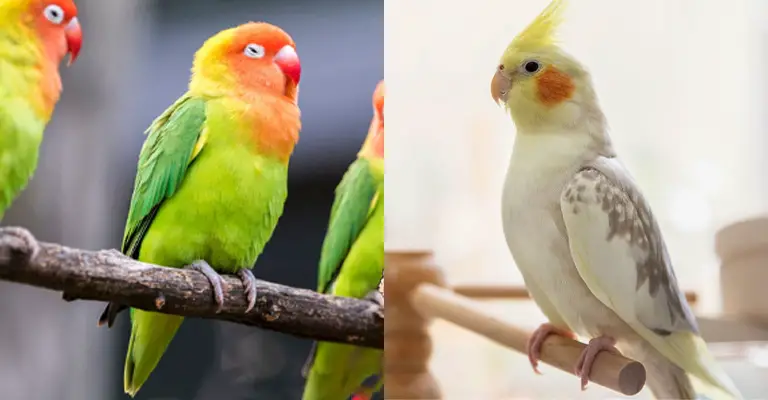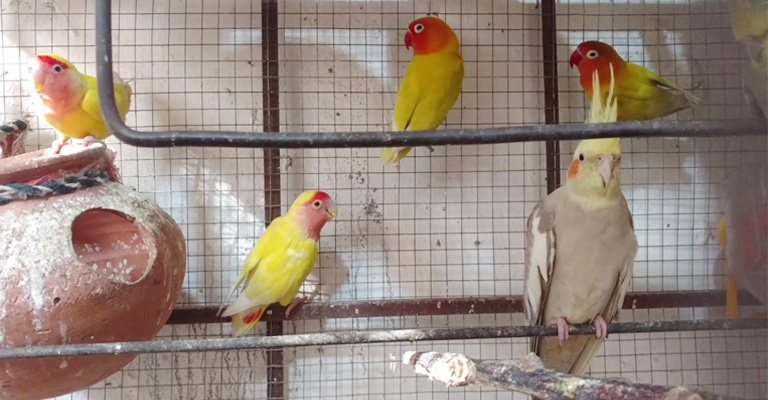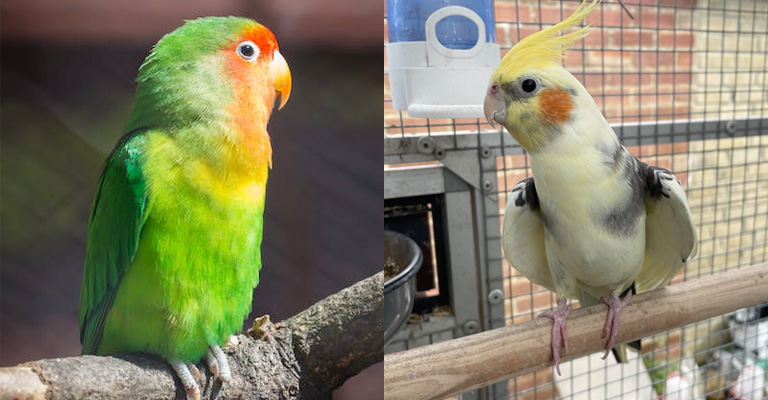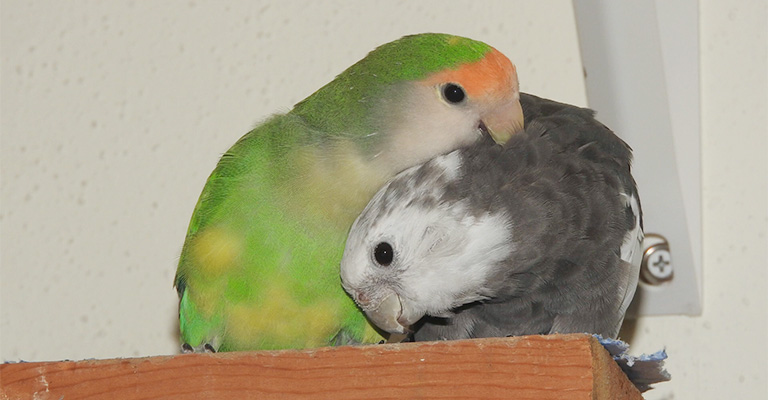The prospect of having two beautiful and affectionate bird species, lovebirds and cockatiels, sharing a single cage might seem like a delightful idea for bird enthusiasts. However, the question ‘Can Lovebirds and Cockatiels Live Together in One Cage?’ is a complex one.
Both lovebirds and cockatiels have their unique temperaments, social behaviors, and size differences that can influence the success of their living arrangements.
In this blog post, we’ll delve into the factors that determine whether lovebirds and cockatiels can peacefully share a cage. We’ll also explore the challenges, potential benefits, and considerations to help you make an informed decision about housing these charming birds together. So, stay focused.

Similarities in the Nature of Lovebirds and Cockatiels
Lovebirds and cockatiels are both popular pet birds known for their affectionate and social nature. One significant similarity is their need for companionship. Both species thrive when they have a companion bird to interact with, as they are highly social creatures.
Additionally, lovebirds and cockatiels are both known for their playful and inquisitive personalities. They enjoy toys and mental stimulation, which helps keep them happy and engaged.
In terms of care, their dietary requirements share similarities as well. Both birds need a balanced diet consisting of seeds, pellets, fresh fruits, and vegetables.
Moreover, lovebirds and cockatiels are appreciated for their charming vocalizations. While lovebirds have a melodious chirp, cockatiels are known for their whistles and the ability to mimic sounds.
So, lovebirds and cockatiels share a need for companionship, playful nature, dietary preferences, and engaging vocalizations, making them popular choices for bird enthusiasts seeking affectionate and entertaining pets.
Can Lovebirds and Cockatiels Live Together in One Cage?

While it is possible for lovebirds and cockatiels to live together in the same cage, it’s not generally recommended. Here are some factors to consider:
Size Difference
Lovebirds are smaller than cockatiels, and size differences can lead to potential conflicts. Cockatiels may unintentionally intimidate or harm lovebirds during interactions.
Aggressive Behavior
Lovebirds can be territorial and aggressive, especially if they feel their space is being invaded. They may become defensive when sharing a cage with a larger bird like a cockatiel.
Different Needs
Lovebirds and cockatiels have slightly different dietary and environmental requirements. Ensuring that both species receive proper nutrition and care can be challenging when they share a cage.
Companionship
While both species are social, they may prefer the company of their own kind. Placing them in separate cages but allowing them to interact outside the cage is a safer way to meet their social needs.
Supervised Interaction
If you do decide to house them together, close supervision is essential. Be prepared to separate them if any signs of aggression or stress are observed.
It’s often recommended to provide each species with its own cage and allow them to interact outside of the cages under supervision. This way, they can enjoy social interaction without the risks associated with cohabitation.
Key Factors That Determine Whether Lovebirds and Cockatiels Can Coexist

Several key factors determine whether lovebirds and cockatiels can coexist harmoniously:
Individual Personalities
The temperament and personalities of the specific birds play a significant role. Some lovebirds and cockatiels may be more tolerant and adaptable to living together, while others may be territorial or aggressive.
Early Socialization
Birds that have been raised together or introduced at a young age are more likely to get along. Birds introduced later in life may have a harder time adjusting to each other’s presence.
Space
Providing a spacious cage is crucial. A larger cage allows birds more room to move and helps reduce territorial disputes. Ensure the cage has multiple perches and hiding spots to create a sense of security.
Companionship
Both lovebirds and cockatiels are social animals, so they benefit from avian companionship. If they have no other option for companionship, they may be more willing to tolerate each other.
Supervision
Regular and close supervision of their interactions is essential, especially initially. This allows you to intervene if aggression or stress-related behaviors emerge.
Compatibility
Some lovebird species are more aggressive than others. Certain cockatiels may also have more assertive personalities. Research the specific species and individuals to understand their compatibility.
Separate Resources
Ensure that both species have access to food, water, toys, and perches. Competition for resources can lead to conflicts.
Training and Socialization
Proper training and socialization techniques can help reduce aggression and encourage positive interactions between the two species.
Health Considerations
Ensure both lovebirds and cockatiels are in good health. Sick or stressed birds are more likely to display aggressive behaviors.
Escape Routes
Provide escape routes or hiding spots within the cage so that if one bird feels threatened, it can retreat to a safe space.
Remember that every bird is unique, and there are no guarantees that lovebirds and cockatiels will get along. Always prioritize the well-being of your birds, and be prepared to separate them if conflicts or stress arise.
Cage and Space Requirements for Lovebirds and Cockatiels

Cage and space requirements for lovebirds and cockatiels are essential to ensure the well-being and happiness of these birds. Here are some guidelines:
Cage Size
- Lovebirds: A cage for a pair of lovebirds should be at least 24 inches (60 cm) in width, depth, and height. The bar spacing should be no more than 1/2 inch (1.27 cm) to prevent escapes or injuries.
- Cockatiels: Cockatiels require a slightly larger cage. A minimum cage size for a single cockatiel should be around 24 inches (60 cm) wide, 18 inches (45 cm) deep, and 24 inches (60 cm) high. For a pair or more, consider a larger cage.
Interior Features
- Perches: Provide multiple perches of varying sizes and textures to encourage exercise and prevent foot problems.
- Toys: Both lovebirds and cockatiels are playful birds. Offer a variety of toys for mental stimulation and entertainment. Toys should be rotated regularly to keep them engaged.
- Food and Water Bowls: Use secure, easy-to-clean bowls for food and water. Stainless steel or ceramic dishes are preferable.
- Nesting Boxes (if breeding): If you intend to breed your birds, provide a suitable nesting box. Make sure it’s appropriately sized for the species.
Location
- Placement: Place the cage in a well-lit, draft-free area away from direct sunlight and extreme temperature fluctuations. Birds need natural light exposure, but avoid placing the cage near radiators, air vents, or windows where temperature extremes can occur.
- Social Interaction: Birds are social creatures and thrive on interaction with their human companions. Keep their cage in an area where you spend a significant amount of time.
Out-of-Cage Time
Both lovebirds and cockatiels require daily out-of-cage exercise and interaction. Provide a safe, bird-proofed space for them to fly and explore. Ensure there are no hazards like toxic plants, open windows, or other pets during this time.
Cleaning
Maintain a clean cage by regularly removing waste, replacing bedding material, and cleaning food and water dishes. A clean environment is crucial for your birds’ health.
Remember that these are minimum guidelines, and providing more space and enrichment is always better for your birds’ well-being.
Diet and Nutrition for Lovebirds and Cockatiels
Proper diet and nutrition are essential for the health and well-being of lovebirds and cockatiels. Here are guidelines for their dietary needs:
Pellets
High-quality pelleted bird food is a good base for their diet. It provides essential nutrients and helps prevent selective eating.
Fresh Vegetables
Offer a variety of fresh, bird-safe vegetables such as carrots, broccoli, spinach, kale, and bell peppers. These provide essential vitamins and minerals.
Fresh Fruits
Provide fresh fruits like apples, bananas, berries, and oranges in moderation. Fruits are a source of vitamins and antioxidants.
Seeds
While seeds can be part of their diet, they should be given in moderation because they are high in fat. Use seeds as treats or supplements rather than the primary food source.
Grains
Cooked grains like rice, quinoa, and pasta can be given occasionally for variety.
Protein
Offer sources of protein like cooked eggs, legumes (cooked beans or lentils), and small amounts of lean, cooked meat (chicken or turkey). Avoid seasoning or spices.
Calcium
Calcium is crucial for birds, especially egg-laying females. Provide a cuttlebone or mineral block for them to nibble on.
Fresh Water
Ensure access to clean, fresh water at all times. Change the water daily to prevent contamination.
Avoid Toxic Foods
Never feed lovebirds and cockatiels foods that are toxic to birds, including chocolate, caffeine, avocado, alcohol, and high-sodium or high-sugar foods.
Vitamin Supplements
If you’re concerned about their nutrition, consult with a veterinarian to determine if a vitamin supplement is necessary. However, in most cases, a balanced diet should provide all the required nutrients.
Monitor Diet and Preferences
Pay attention to your birds’ preferences and monitor their diet. Encourage a varied diet to ensure they receive all essential nutrients.
Avoid Overfeeding
Be cautious not to overfeed your birds. Obesity is a common problem in pet birds, so measure their portions and monitor their weight.
Freshness
Ensure that all fruits, vegetables, and other fresh foods are fresh and free of pesticides or contaminants.
Dietary Changes
If you plan to make significant changes to their diet, do so gradually to avoid digestive upset.
Remember that individual birds may have different dietary preferences and needs, so it’s essential to observe your lovebirds and cockatiels and adjust their diet accordingly.
Potential Challenges in Keeping Lovebirds and Cockatiels Together
Keeping lovebirds and cockatiels together in the same cage or environment can present several potential challenges. Here are some of the key issues to consider:
Compatibility Issues
Lovebirds and cockatiels have different temperaments, and not all individuals will get along. Lovebirds can be feisty and territorial, while cockatiels are generally more gentle. Aggressive behavior or bullying can occur, leading to stress and injuries.
Size and Strength Differences
Lovebirds are smaller than cockatiels. The size and strength differential can result in lovebirds feeling intimidated or being physically harmed by the larger cockatiels during interactions.
Bullying and Aggression
Lovebirds can be aggressive, particularly when they feel their territory is threatened. They may try to dominate the space and resources, leading to stress and conflict between the two species.
Resource Competition
Lovebirds and cockatiels may compete for food, water, toys, and perches. Ensuring both species have access to these resources can be challenging in a shared cage.
Nesting Behavior
Lovebirds are known for their strong nesting instincts, and they may become territorial if they perceive a nesting site within the cage. This can lead to aggression towards the cockatiels.
Health Risks
If one bird carries a contagious disease or parasite, it can easily spread to the other bird when they share the same environment. Regular veterinary check-ups and quarantine procedures for new birds are essential.
Stress
Constant interaction and sharing of space can lead to stress for both species, which can result in health issues and behavioral problems.
Dietary Differences
Lovebirds and cockatiels have slightly different dietary requirements. Ensuring they both receive the appropriate nutrition can be challenging when they share a cage.
Separation Needs
Both lovebirds and cockatiels need time away from their cage to exercise and socialize outside. Providing separate out-of-cage time or separate play areas is essential.
Supervision
If you do decide to house them together, close and consistent supervision is required to ensure their safety and well-being. Be prepared to intervene if conflicts arise.
In some cases, lovebirds and cockatiels can coexist harmoniously, especially if they have been raised together from a young age and their personalities are compatible.
However, it’s essential to be cautious, monitor their interactions closely, and have a plan in place to separate them if necessary.
FAQs
While it’s possible, it’s not generally recommended. Lovebirds and cockatiels have different personalities and size differences that can lead to conflicts. They are better off in separate cages with supervised social interaction outside of the cages.
Yes, there are exceptions, especially if they have been raised together from a young age and have compatible personalities. However, close monitoring is essential, and be prepared to separate them if aggression or stress occurs.
Ensure a spacious cage with multiple perches and hiding spots. Provide separate food and water dishes to prevent resource competition. Supervise their interactions closely, especially initially, and have a backup plan to separate them if needed.
Watch for signs of aggression, stress, or territorial behavior, such as excessive fighting, feather plucking, or one bird dominating resources. If these issues arise, it’s best to separate them for their well-being.
Yes, they can socialize outside of their cages under supervision. Ensure a safe, bird-proofed area free of hazards, and monitor their interactions. This allows them to enjoy each other’s company while reducing the risks associated with cohabitation.
Wrapping Up
The decision to house lovebirds and cockatiels together in one cage requires careful consideration. While it is possible for them to coexist, it’s not without its challenges.
Their individual personalities, size differences, and social behaviors play pivotal roles in determining whether they can live harmoniously.
Providing a spacious and well-equipped cage, close supervision, and a backup plan for separation are vital steps to ensure their well-being.
Whether they share a cage or enjoy supervised social time outside it, prioritizing the health and happiness of your avian companions is paramount in fostering a fulfilling and enriching bond between lovebirds and cockatiels. Best of luck.